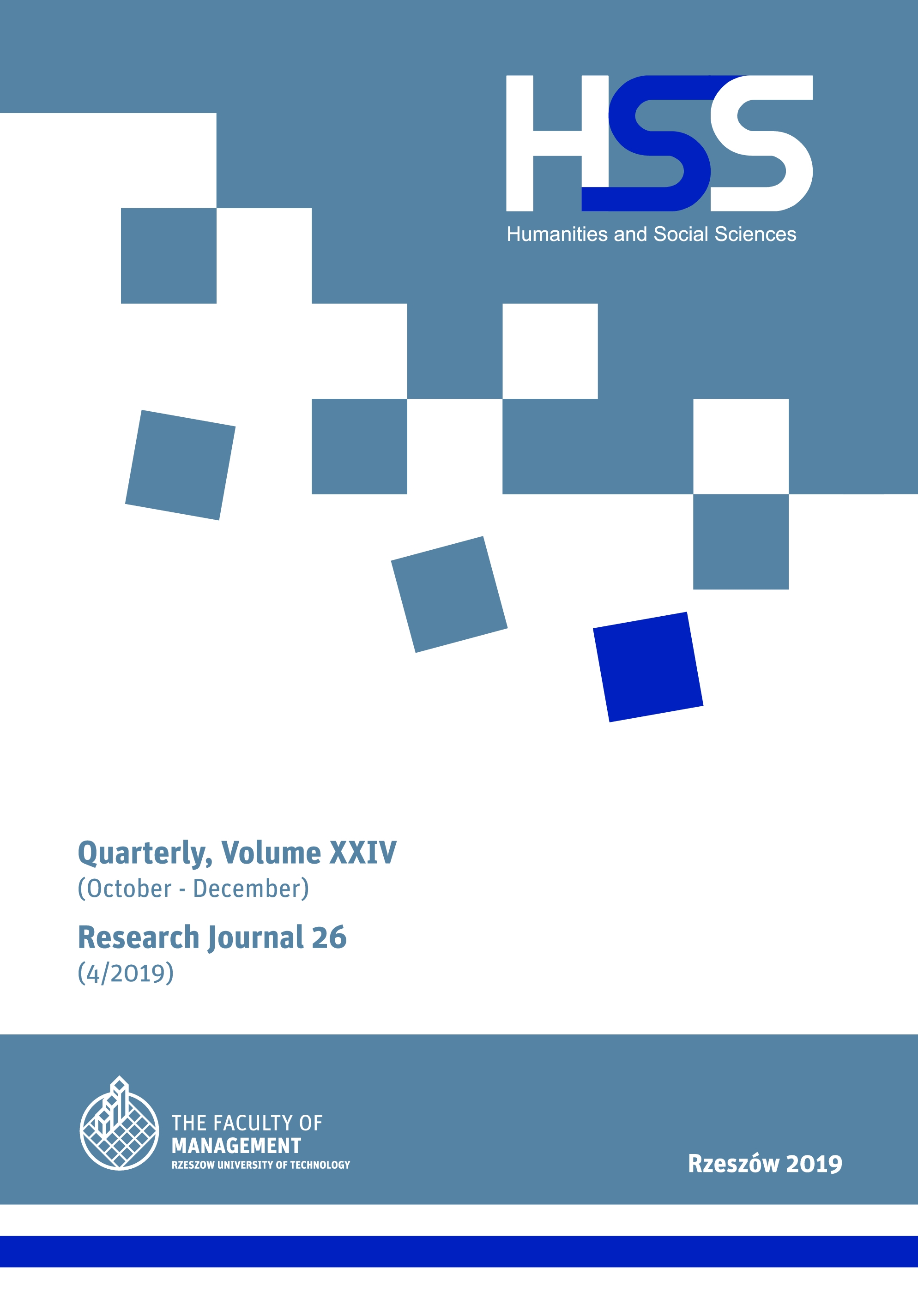Abstract
Social media is one of the most important and popular platforms to exchange information on new products and services. Social media is particularly important for purchasing decisions by young adults, called Millennials. The main goal of the article is to examine the role of social media in obtaining information on innovative products by Millennials. In addition, the research analyses differences in perceptions of the role social media plays in the purchasing process, including the gender of surveyed buyers. The hypotheses are based on a conceptual model utilising the theory of innovation diffusion and the theory of consumer behaviour. We used Structural Equation Modeling (SEM) as a research method. The research sample consisted of buyers representing the Millennial generation. The findings confirmed the positive impact of the selected factors on using social media to search for innovative products. The study also confirmed gender differences in perceptions of the importance of social media. The biggest differences between men and women relate to assessing the importance of information availability, convenience, and habit.
References
Al Majzoub, K., Vida Davidavičienė, V. (2019). Development of ICT: Conceptual Comparative Analysis of Consumer Behavior in Europe and Asia. Contemporary Issues in Business, Management and Economics Engineering’2019, International Scientific Conference, 9–10 May 2019, Vilnius, Lithuania. DOI: 10.3846/cibmee.2019.090.
Angowski, M., Kijek, T. (2017). Segmentacja nabywców na podstawie analizy czynników wpływających na wybór produktów żywnościowych. „Humanities and Social Sciences”, Vol. 22, No. 24(3). DOI: 10.7862/rz.2017.hss.40.
Asada, A., Ko, J.Y. (2019) Perceived Influence of Word-of-Mouth Recommendation on Sport-Watching Behavior: A Gender Difference Perspective. “Sport Marketing Quarterly”, Vol. 28. DOI: 10.32731/SMQ.283.092019.02.
Ashraf, R.U., Hou, F., Ahmad, W.(2019) Understanding Continuance Intention to Use Social Media in China: The Roles of Personality Drivers, Hedonic Value, and Utilitarian Value. “International Journal of Human–Computer Interaction”, Vol. 35, 13. DOI: 10.1080/10447318.2018.1519145
Chu SC, Kim Y. (2011) Determinants of consumer engagement in electronic word-of-mouth (eWOM) in social networking sites. “International Journal of Advertising”, Vol. 30, No. 1. DOI: 10.2501/IJA-30-1-047-075.
Deluga, W. (2015). Miejsce gender marketingu w postępowaniu nabywców na rynku dóbr szybko zbywalnych. „Problemy Profesjologii”, Vol. 1.
Duarte, P., Costa e Silva, S., Ferreira, M.B. (2018). How convenient is it? Delivering online shopping convenience to enhance customer satisfaction and encourage e-WOM. “Journal of Retailing and Consumer Services”, Vol. 44(C). DOI: 10.1016/j.jretconser.2018.06.007.
Erkan, I., Elwalda, A., Rahman, M., Sap, S., Doğan, S. (2017). Mobile word of mouth (MWOM) in messaging applications: An integrative framework of the impact of MWOM communication. “International Journal of Applied Business and Management Studies”, Vol. 2, No. 1.
Erkan, I., Evans, C. (2016). Social media or shopping websites? The influence of eWOM on consumers’ online purchase intentions. “Journal of Marketing Communications”. DOI: 10.1080/13527266.2016.1184706.
Kąkol, P. (2017). Communication and its differences among men and women. “Humanities and Social Sciences”, Vol. 22, 24 (3/2017). DOI: 10.7862/rz.2017.hss.48.
Kim, S., Eastin, M.S. (2011). Hedonic Tendencies and the Online Consumer: An Investigation of the Online Shopping Process. “Journal of Internet Commerce”, Vol. 10. DOI: 10.1080/15332861.2011.558458.
Kowalska, M. (2019). Rola płci w budowaniu relacji na poziomie afektywnym w środowisku online na przykładzie generacji Y. „Przedsiębiorczość i Zarządzanie”, Vol. 20, 6.
Kuczamer-Kłopotowska, S. (2016) Rola mediów społecznościowych w komunikacji pokolenia Y. „Handel Wewnętrzny”, 3, 362.
Lipowski, M., Angowski, M. (2016). Gender and consumer behaviour in distribution channels of services. “International Journal of Synergy and Research”, Vol. 5. DOI: 10.17951/ijsr.2016.5.45.
Lipowski, M., Bondos, I. (2016). Omnikanałowość-czy rynek zweryfikuje koncepcję teoretyczną. „Organizacja i Zarządzanie”, No. 1.
Mysona Byrska, J. (2016). The female consumer,w she is, who she wants to be and who she cannot be as a consumer. “Humanities and Social Sciences”, Vol. 21, 23 (4/2016). DOI: 10.7862/rz.2016.hss.70.
Nguyen, D.H., Leeuw, S., Dullaert, W.E.H. (2018). Consumer behaviour and order fulfilment in online retailing – A systematic review. “International Journal of Management Reviews”, Vol. 20. DOI: 10.1111/ijmr.12129.
Pauwels, K., Leeflang, P.S.H., Teerling, M.L., Huizingh, K.R.E. (2011). Does Online Information Drive Offline Revenues? Only for specific Products and Consumer Segments! “Journal of Retailing”, 87, 1. DOI: 10,1016/j.jretai.2010.10.001.
Pöyry, E., Parvinen, P., Malmivaara, T. (2013). Can we get from liking to buying? Behavioral differences in hedonic and utilitarian Facebook usage. “Electronic Commerce Research and Applications”, Vol. 12. DOI: 10.1016/j.elerap.2013.01.003.
Rezaei, S., Valaei, N. (2017). Branding in a multichannel retail environment. “Information Technology & People”, Vol. 30, No. 4. DOI: 10.1108/ITP-12-2015-0308.
Richard, M-O. Chebat, J-C., Yang, Z., Putrevu, S. (2010). A proposed model of online consumer behavior: Assessing the role of gender. “Journal of Business Research”, Vol. 63. DOI: 10.1016/j.jbusres.2009.02.027.
Sánchez Torres, J.A., Arroyo-Cañada, F.J., Solé-Moro, M.L., Argila-Irurita, A. (2017). Impact of gender on the acceptance of electronic word-of-mouth (eWOM) information in Spain. “Contaduría y Administración”, Vol. 63, No. 4. DOI: 10.22201/fca.24488410e.2018.1428.
Sands, S., Ferraro, C., Campbell, C., Pallant,J. (2016). Segmenting multichannel consumers across search, purchase and after-sales. “Journal of Retailing and Consumer Services”, No. 33. DOI: 10.1016/j.jretconser.2016.08.001.
Shao, P., Chen, H. (2019). Driving Factors for Opinion Diffusion Behavior in Consumers on Online Social Networks: A Study of Network Characteristics. IEEE Access, Vol. 7. DOI: 10.1109/ACCESS.2019.2932571.
Szlegr, M. (2018). Analiza zachowań konsumentów podczas zakupów on-line. “MIND Journal”, No. 5.
Tkaczyk, J. (2015) Źródła informacji w procesie podejmowania decyzji o zakupie przez e-konsumentów – Polska na tle innych państw UE. „Marketing i Rynek”, No. 8.
Trivedi, R.H., Teichert, T. (2019). The effect of ad smiles on consumer attitudes and intentions: Influence of model gender and consumer gender. “Journal of Business Research”, Vol. 99. DOI: 10.1016/j.jbusres.2019.02.052.
Voorveld, H.A.M., Smit, E.G. Neijens, P.C., Bronner, A.E.F. (2016). Consumers’ Cross-Channel Use in Online and Offline Purchases. An Analysis of Cross-Media And Cross-Channel Behaviors between Products. “Journal of Advertising Research”, 12. DOI: 10.2501/JAR-2016-044 D.
Zatwarnicka-Madura, B. (2016). Online marketing communication directed to women in the car market. “Humanities and Social Sciences”, Vol. 21, 23(3/2016). DOI: 10.7862/rz.2016.hss.56.
Zhang, K.Z. and Benyoucef, M. (2016). Consumer behavior in social commerce: a literature review. “Decision Support Systems”, Vol. 86, No. 1. DOI: 10.1016.j.dss.2016.04.001.


